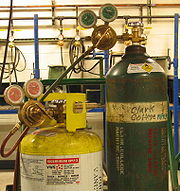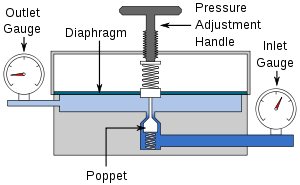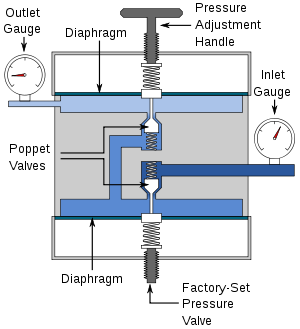
Pressure regulator
Encyclopedia

Valve
A valve is a device that regulates, directs or controls the flow of a fluid by opening, closing, or partially obstructing various passageways. Valves are technically pipe fittings, but are usually discussed as a separate category...
that automatically cuts off the flow of a liquid or gas at a certain pressure. Regulators are used to allow high-pressure fluid supply lines or tanks to be reduced to safe and/or usable pressures for various applications.
Gas pressure regulators are used to regulate the gas pressure and are not appropriate for measuring flow rates. Flowmeters, Rotometers or Mass Flow Controller
Mass Flow Controller
A mass flow controller is a device used to measure and control the flow of fluids and gases. A mass flow controller is designed and calibrated to control a specific type of fluid or gas at a particular range of flow rates...
s should be used to accurately regulate gas flow rates.
Operation


A pressure regulator includes a restricting element, a loading element, and a measuring element:
- The restricting element is a type of valve. It can be a globe valveGlobe valveA globe valve is a type of valve used for regulating flow in a pipeline, consisting of a movable disk-type element and a stationary ring seat in a generally spherical body....
, butterfly valveButterfly valveA butterfly valve is a valve which can be used for isolating or regulating flow. The closing mechanism takes the form of a disk. Operation is similar to that of a ball valve, which allows for quick shut off. Butterfly valves are generally favored because they are lower in cost to other valve...
, poppet valvePoppet valveA poppet valve is a valve consisting of a hole, usually round or oval, and a tapered plug, usually a disk shape on the end of a shaft also called a valve stem. The shaft guides the plug portion by sliding through a valve guide...
, or any other type of valve that is capable of operating as a variable restriction to the flow. - The loading element applies the needed force to the restricting element. It can be any number of things such as a weight, a spring, a piston actuator, or more commonly the diaphragm actuator in combination with a spring.
- When the actuator is forced against an expansion disk, the force is distributed among the pressure walls. This allows the gas to flow at the proper rate and not to be continually vaporized and diluted.
- The measuring element determines when the inlet flow is equal to the outlet flow. The diaphragm is often used as a measuring element because it can also serve as a combine element.
In the pictured single-stage regulator, a diaphragm is used with a poppet valve to regulate pressure. As pressure in the upper chamber increases, the diaphragm is pushed upward, causing the poppet to reduce flow, bringing the pressure back down. By adjusting the top screw, the downward pressure on the diaphragm can be increased, requiring more pressure in the upper chamber to maintain equilibrium. In this way, the outlet pressure of the regulator is controlled.
Water pressure reduction
Often, water enters water-using appliances at fluctuating pressures, especially in remote locations, and industrial settings. This pressure often needs to be kept within a range to avoid damage to appliances, or accidents involving burst pipes/conduits. A single-stage regulator is sufficient in accuracy due to the high error tolerance of most such appliances.Oxy-fuel welding and cutting
Oxy-fuel welding and cuttingOxy-fuel welding and cutting
Oxy-fuel welding and oxy-fuel cutting are processes that use fuel gases and oxygen to weld and cut metals, respectively. French engineers Edmond Fouché and Charles Picard became the first to develop oxygen-acetylene welding in 1903...
processes require gases at specific pressures, and regulators will generally be used to reduce the high pressures of storage cylinders
Gas cylinder
A gas cylinder is a pressure vessel used to store gases at above atmospheric pressure. High pressure gas cylinders are also called bottles. Although they are sometimes colloquially called "tanks", this is technically incorrect, as a tank is a vessel used to store liquids at ambient pressure and...
to those usable for cutting and welding. Oxy-gas regulators usually have two stages: The first stage of the regulator releases the gas at a constant rate from the cylinder despite the pressure in the cylinder becoming less as the gas is released. The second stage of the regulator controls the pressure reduction from the intermediate pressure to low pressure. It is constant flow. The valve assembly has two pressure gauges, one indicating cylinder pressure, the other indicating hose pressure.
Propane/LP Gas
All propanePropane
Propane is a three-carbon alkane with the molecular formula , normally a gas, but compressible to a transportable liquid. A by-product of natural gas processing and petroleum refining, it is commonly used as a fuel for engines, oxy-gas torches, barbecues, portable stoves, and residential central...
and LP Gas applications require the use of a regulator. Because pressures in propane tanks can fluctuate significantly, regulators must be present to deliver a steady flow pressure to downstream appliances. These regulators normally compensate for tank pressures between 30 - 200psig and commonly deliver 11 inches water column
Inch of water
Inches of water, wc, inch water column , inAq, Aq, or inH2O is a non-SI unit for pressure. The units are by convention and due to the historical measurement of certain pressure differentials. It is used for measuring small pressure differences across an orifice, or in a pipeline or shaft...
(0.4 psig) for residential applications and 35 inches of water column (1.3 psig) for industrial applications. Propane regulators differ in size and shape, delivery pressure and adjust-ability but are uniform in their purpose to deliver a constant outlet pressure for downstream requirements. As is the case in all regulators, outlet pressure is lower than inlet pressure.
Recreational vehicles
For recreational vehicles with plumbing, a pressure regulator is a necessity. When camping, a source of water may have an enormous pressure level, particularly if it comes from a tank that is at a much higher elevation than the campground. Water pressure is dependent on how far the water must fall. Without a pressure regulator, the intense pressure encountered at some campgrounds in mountainous areas may be enough to burst the camper's water pipes or unseat the plumbing joints, causing flooding. Pressure regulators for this purpose are typically sold as small screw-on accessories that fit inline with the hoses used to connect an RV to the water supply, which are almost always screw-thread-compatible with the common garden hoseGarden hose
A garden hose is a flexible tube used to carry water. There are a number of common attachments available for the end of the hose, such as sprayers and sprinklers...
.
Breathable air supply
Pressure regulators are used with air tankAir tank
Air tank may refer to:* diving cylinder used by scuba divers to hold air and other breathing gases at high pressure underwater* Pneumatic pressure vessel for storing compressed air to operate pneumatic equipment such as braking systems, paint dispensers and paintball guns...
s for SCUBA diving
Scuba diving
Scuba diving is a form of underwater diving in which a diver uses a scuba set to breathe underwater....
. The tank may contain pressures well in excess of 2,000psig, which could cause a fatal barotrauma
Barotrauma
Barotrauma is physical damage to body tissues caused by a difference in pressure between an air space inside or beside the body and the surrounding fluid...
injury to a person breathing it directly. A regulator allows only a sustained flow of air at the ambient pressure (which varies by depth in the water).

